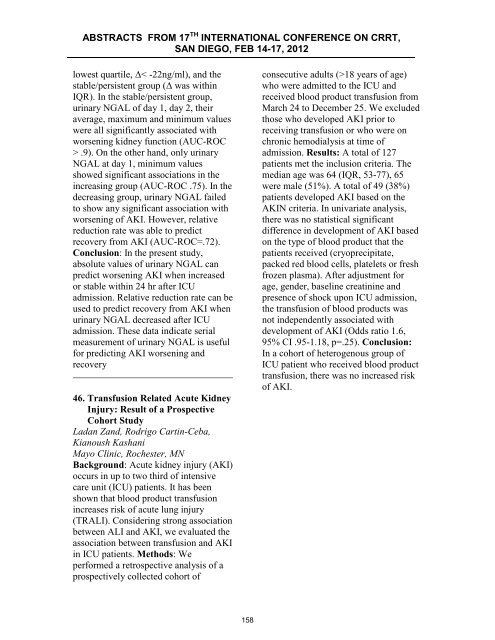ABSTRACTS from 16th International COnference on ... - CRRT Online
ABSTRACTS from 16th International COnference on ... - CRRT Online
ABSTRACTS from 16th International COnference on ... - CRRT Online
Create successful ePaper yourself
Turn your PDF publications into a flip-book with our unique Google optimized e-Paper software.
<str<strong>on</strong>g>ABSTRACTS</str<strong>on</strong>g> FROM 17 TH INTERNATIONAL CONFERENCE ON <strong>CRRT</strong>,<br />
SAN DIEGO, FEB 14-17, 2012<br />
lowest quartile, Δ< -22ng/ml), and the<br />
stable/persistent group (Δ was within<br />
IQR). In the stable/persistent group,<br />
urinary NGAL of day 1, day 2, their<br />
average, maximum and minimum values<br />
were all significantly associated with<br />
worsening kidney functi<strong>on</strong> (AUC-ROC<br />
> .9). On the other hand, <strong>on</strong>ly urinary<br />
NGAL at day 1, minimum values<br />
showed significant associati<strong>on</strong>s in the<br />
increasing group (AUC-ROC .75). In the<br />
decreasing group, urinary NGAL failed<br />
to show any significant associati<strong>on</strong> with<br />
worsening of AKI. However, relative<br />
reducti<strong>on</strong> rate was able to predict<br />
recovery <str<strong>on</strong>g>from</str<strong>on</strong>g> AKI (AUC-ROC=.72).<br />
C<strong>on</strong>clusi<strong>on</strong>: In the present study,<br />
absolute values of urinary NGAL can<br />
predict worsening AKI when increased<br />
or stable within 24 hr after ICU<br />
admissi<strong>on</strong>. Relative reducti<strong>on</strong> rate can be<br />
used to predict recovery <str<strong>on</strong>g>from</str<strong>on</strong>g> AKI when<br />
urinary NGAL decreased after ICU<br />
admissi<strong>on</strong>. These data indicate serial<br />
measurement of urinary NGAL is useful<br />
for predicting AKI worsening and<br />
recovery<br />
46. Transfusi<strong>on</strong> Related Acute Kidney<br />
Injury: Result of a Prospective<br />
Cohort Study<br />
Ladan Zand, Rodrigo Cartin-Ceba,<br />
Kianoush Kashani<br />
Mayo Clinic, Rochester, MN<br />
Background: Acute kidney injury (AKI)<br />
occurs in up to two third of intensive<br />
care unit (ICU) patients. It has been<br />
shown that blood product transfusi<strong>on</strong><br />
increases risk of acute lung injury<br />
(TRALI). C<strong>on</strong>sidering str<strong>on</strong>g associati<strong>on</strong><br />
between ALI and AKI, we evaluated the<br />
associati<strong>on</strong> between transfusi<strong>on</strong> and AKI<br />
in ICU patients. Methods: We<br />
performed a retrospective analysis of a<br />
prospectively collected cohort of<br />
c<strong>on</strong>secutive adults (>18 years of age)<br />
who were admitted to the ICU and<br />
received blood product transfusi<strong>on</strong> <str<strong>on</strong>g>from</str<strong>on</strong>g><br />
March 24 to December 25. We excluded<br />
those who developed AKI prior to<br />
receiving transfusi<strong>on</strong> or who were <strong>on</strong><br />
chr<strong>on</strong>ic hemodialysis at time of<br />
admissi<strong>on</strong>. Results: A total of 127<br />
patients met the inclusi<strong>on</strong> criteria. The<br />
median age was 64 (IQR, 53-77), 65<br />
were male (51%). A total of 49 (38%)<br />
patients developed AKI based <strong>on</strong> the<br />
AKIN criteria. In univariate analysis,<br />
there was no statistical significant<br />
difference in development of AKI based<br />
<strong>on</strong> the type of blood product that the<br />
patients received (cryoprecipitate,<br />
packed red blood cells, platelets or fresh<br />
frozen plasma). After adjustment for<br />
age, gender, baseline creatinine and<br />
presence of shock up<strong>on</strong> ICU admissi<strong>on</strong>,<br />
the transfusi<strong>on</strong> of blood products was<br />
not independently associated with<br />
development of AKI (Odds ratio 1.6,<br />
95% CI .95-1.18, p=.25). C<strong>on</strong>clusi<strong>on</strong>:<br />
In a cohort of heterogenous group of<br />
ICU patient who received blood product<br />
transfusi<strong>on</strong>, there was no increased risk<br />
of AKI.<br />
158
















